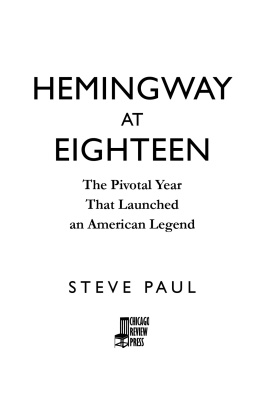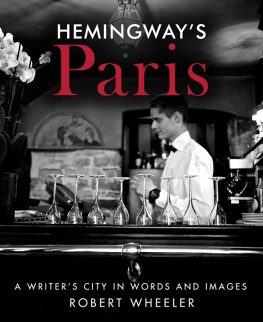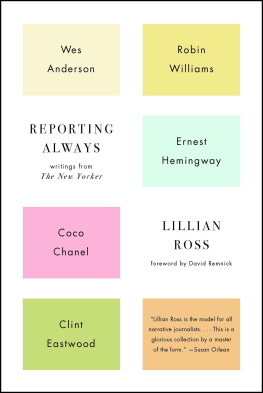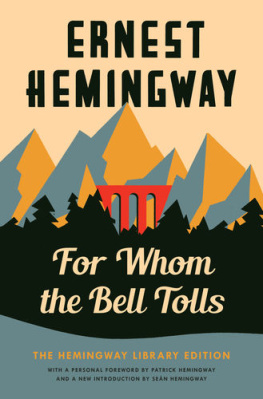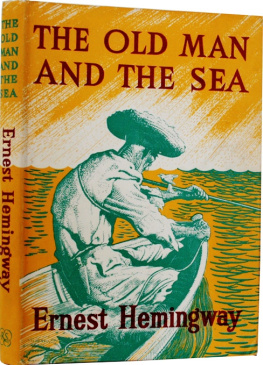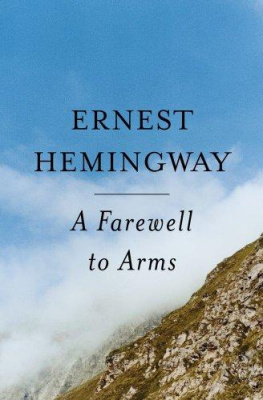Foreword
E rnest Hemingway was born five months in front of the twentieth century, on July 21, 1899. Among other things, this makes keeping mental track of his age a relatively easy task. For instance: we know without needing to think about it that Pearl Harbor happened on December 7, 1941thus, Hemingway must have been forty-two. The Wright brothers flew at Kitty Hawk in December 1903, ergo a sturdy little incipient genius in Oak Park in his short pants had to have been nearly five months past his fourth birthday. (Come to think, maybe he was in woolen knickers that dayit was the onset of an Illinois winter.) JFK in Dealey Plaza? If Hemingway were alive (he was two years dead), he would have been sixty-four. This instant calculating tool or clocking device or whatever you wish to call it works just as effortlessly for events in the authors own life. If you know when The Sun Also Rises came out (fall of 1926), then you automatically know he was twenty-seven. Since I am a person challenged by math, it occurs to me to say that, along with all the gifts Hemingway left us, for all time, he slyly slid under the door jamb this one: puny, and not puny at all.
It occurs to me to say that the sly gift Steve Paul has given us in Hemingway at Eighteen is an idea that has been hiding in plain sight for a long time. He takes us into one extraordinary year in an extraordinary lifenamely, from July 21, 1917, to July 21, 1918and has the cheek to try to make the part stand for the whole. In his introduction he allows that his project is essentially presumptuous, the notion that any biographer might find, like a pearl resting inside a shell, the whole of the man in a single, twelve-month grain of sand. I agree: such a thing isnt quite possible. It is a bit presumptuous. A synecdoche is finally a synecdoche. But you can come damn close, and, in fact, Paul does. In this short, pointed work, which doesnt attempt to oversell itself, I have learned nearly as much about Hemingwayor at least gotten a visceral feel for the young Ernest Hemingwayas I have from works twice or three times this size. In the bargain, as I read, I was getting a good visceral feel for the young twentieth century itself. In full, as we know, it was a century of blood and grief, of mass slaughters the world hadnt previously conjured, even as it was a century of stupendous (and not-conjured) technological and scientific breakthrough. It was a century of art and literature, too. It was as if the century at seventeen going on eighteen, no less than the boy-man at eighteen, was foreshadowing all that each would separately be.
It is a fools errandwhich Paul doesnt runto bother oneself with the question of: What was the most critical year in Hemingways life? Thats like asking: What was the single most important year of the twentieth century? Leave it at this: the period of 19171918, for both America and Hemingway, was hugely important. For both century and man, there was an exit from the garden, a kind of going from innocence to sin, from shelter to what Bob Dylan might call no direction home. For Hemingway, the going, in the early part of his eighteenth-ness, was from the protections of suburban Oak Park and the big family house on Kenilworth Avenue (never mind that there was doom lurking inside that house) to the wide-open grit and protofrontier joys of Kansas City. It was his first real job, and it was on a great American newspaper. It is reductionist and oversimplifying the matter to say that Hemingway learned to write in those six and a half months that he spent as a cub at the Kansas City Star. Reductionist and oversimplifying, OK, but unarguable, too, that the Star taught him things about the power of short, declarative, linear, action-based American sentences. Such sentences became the brick and mortar of the uncopy-able Hemingway style. (You can parody the Hemingway style, but you cant begin to copy it.)
Steve Paul, who spent a long, honorable career at the Star, in what he unashamedly thinks of as the brotherhood of the Star, and who is now recently retired from his inky labors there (though I doubt retired from the brotherhood aspects), is superbly qualified to tell us this tale.
The second part of the year of eighteenth-ness, as every Hemingway student knows, has to do with the war in Europe. He left Missouri and went into the still-wider world, where there was nothing proto about the violence. He entered the ambulance service of the American Red Cross and, two weeks before his nineteenth birthday, was blown upspiritually more than physically, but physically all the sameon the iconic banks of the Piave River. Well, if the banks werent iconic then, they were destined to be, through the myth of his life, the myth of his writing. It is equally reductionist and oversimplifying to say that what happened on the front in Italy gave Hemingway the material he needed to become an immortal figure in our literature. But at the same time it is unarguable that that experience, terrible as it was, was the brick and mortar (in two senses of the word mortar) of some beautiful edifices to come.
The Kansas City days and the World War I days were brief things for Ernest Hemingway. It didnt matter. As he told us in another place, it is never the duration of an experience but rather the intensity of an experience that matters. If you feel it authentically enough, the sensation will last you a lifetime. And us, too.
Paul Hendrickson, October 2016
Paul Hendrickson is the author of Hemingways Boat (2011), which primarily traces the last thirty years of Ernest Hemingways life. After a long career as a staff writer at the Washington Post, he joined the creative writing faculty at the University of Pennsylvania. A previous book, Sons of Mississippi, won the National Book Critics Circle Award in general nonfiction.

